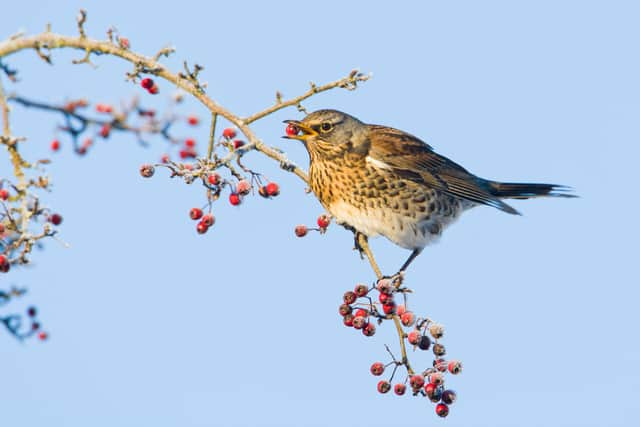Berry boost for Sussex birds after record hawthorn crop
and live on Freeview channel 276
Hedgerows and woodland across the county are awash with the red berries which nature experts at the Woodland Trust are describing as one of the biggest ever crops.
Nature’s Calendar recorders have sent in reports with this year’s crop being given 4.2 on the fruit scale – deemed as “exceptional”. This takes in dozens of records where hawthorns are judged on the abundance of their berries, also known as haws.
Advertisement
Hide AdAdvertisement
Hide AdThe Nature’s Calendar team has been reporting on this for the last 20 years, and with records still coming in, it’s the largest fruit score ever (equalled only in 2014).


Dr Judith Garforth, the Woodland Trust’s Citizen Science Officer, said:
“This is really good autumn news for wildlife. Haws are eaten by migrating birds such as redwings, fieldfares and thrushes as well as small mammals.
“The fruit score is really important as it provides an indicator of winter food availability for wildlife, as well as the seed source available for natural regeneration of trees and shrubs, it’s often linked to climate variables in preceding seasons.”
Advertisement
Hide AdAdvertisement
Hide AdThe Nature’s Calendar team puts the exceptional crop down to a mild spring where temperatures hovered above average. This is when the white hawthorn flowers bloom which, if pollinated, go on to produce the red fruits in autumn.
Nature’s Calendar volunteers also record the date that hawthorn flowers first start to open in spring. The data shows that the UK average date of first flowering of hawthorn was 1st May this year. This was perfect timing for its common name the ‘May tree’. The warm dry weather in May was ideal for pollinating insects.
Whilst Dr Garforth celebrated the news, she cautioned that a shortage of volunteer recorders could put such record gathering at risk. “We desperately need more recorders to deliver such data which is so important for tracking the nation’s seasons. We’re incredibly lucky to have historic data going back almost 300 years, but to understand how wildlife is responding to the changing climate, we need new volunteers to continue the record into the future.
“Becoming a recorder is a great way to get into the outdoors but you can even chart nature by looking out of your window. So please do come forward – anyone can take part, you don’t’ need to be scientist!”
Advertisement
Hide AdAdvertisement
Hide AdHave you read? Take a look inside the most haunted pub in Sussex
Visit www.naturescalendar.woodlandtrust.org.uk to find out more about being a recorder.
Nature's Calendar is supported by players of People's Postcode Lottery.Laura Chow, Head of Charities at People's Postcode Lottery, which supports the scheme, said: “We're delighted our players are supporting this important research. Now is a great time to get out into our woods which are awash with colour, not least from the hawthorns where there is a bumper crop of berries!”